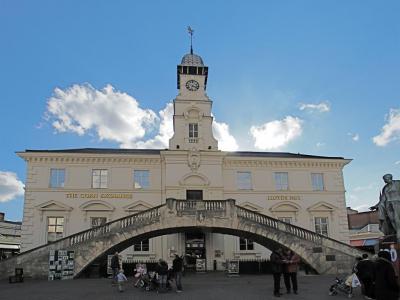Leicester Corn Exchange, Leicester
Standing at the heart of Leicester’s Market Place, the Leicester Corn Exchange is a striking example of 19th-century neoclassical architecture that has evolved through centuries of commercial, legal, and civic use. This Grade II* listed building, now a bustling public house, has a layered history dating back to the early 16th century.
The site originally housed The Gainsborough, a multi-purpose structure completed in 1509 that served as a prison and law court, complete with dungeons and shops below. It was replaced in 1748 by the New Gainsborough, specifically built as a corn exchange, with magistrates’ courts operating on the upper floor.
The current building took shape in 1851 as a single-storey market hall, designed by William Flint. Just four years later, architect Frederick Webster Ordish expanded it, adding a grand second floor to accommodate magistrates’ hearings. The neoclassical façade, executed in brick with a stucco finish, features a symmetrical seven-bay frontage, a prominent stone archway with a double-flight staircase, and elegant windows adorned with alternating triangular and segmental pediments. A clock turret by Leicester’s E. T. Loseby, topped with a wyvern-shaped weather vane, crowns the building. While historian Nikolaus Pevsner called the staircase "spectacular," Ordish later disowned his design.
A statue of John Manners, 5th Duke of Rutland, was added in 1852. As agriculture declined, so did trade at the Corn Exchange, which later became a hub for public events, including the 1911 coronation celebrations and a 1914 debate with Ramsay MacDonald. After years of decline, Wetherspoons restored it as a public house in 2000, preserving its historic charm while giving it new life. Today, it remains a key architectural and social landmark in Leicester.
The site originally housed The Gainsborough, a multi-purpose structure completed in 1509 that served as a prison and law court, complete with dungeons and shops below. It was replaced in 1748 by the New Gainsborough, specifically built as a corn exchange, with magistrates’ courts operating on the upper floor.
The current building took shape in 1851 as a single-storey market hall, designed by William Flint. Just four years later, architect Frederick Webster Ordish expanded it, adding a grand second floor to accommodate magistrates’ hearings. The neoclassical façade, executed in brick with a stucco finish, features a symmetrical seven-bay frontage, a prominent stone archway with a double-flight staircase, and elegant windows adorned with alternating triangular and segmental pediments. A clock turret by Leicester’s E. T. Loseby, topped with a wyvern-shaped weather vane, crowns the building. While historian Nikolaus Pevsner called the staircase "spectacular," Ordish later disowned his design.
A statue of John Manners, 5th Duke of Rutland, was added in 1852. As agriculture declined, so did trade at the Corn Exchange, which later became a hub for public events, including the 1911 coronation celebrations and a 1914 debate with Ramsay MacDonald. After years of decline, Wetherspoons restored it as a public house in 2000, preserving its historic charm while giving it new life. Today, it remains a key architectural and social landmark in Leicester.
Want to visit this sight? Check out these Self-Guided Walking Tours in Leicester. Alternatively, you can download the mobile app "GPSmyCity: Walks in 1K+ Cities" from Apple App Store or Google Play Store. The app turns your mobile device to a personal tour guide and it works offline, so no data plan is needed when traveling abroad.
Leicester Corn Exchange on Map
Sight Name: Leicester Corn Exchange
Sight Location: Leicester, England (See walking tours in Leicester)
Sight Type: Attraction/Landmark
Sight Location: Leicester, England (See walking tours in Leicester)
Sight Type: Attraction/Landmark
Walking Tours in Leicester, England
Create Your Own Walk in Leicester
Creating your own self-guided walk in Leicester is easy and fun. Choose the city attractions that you want to see and a walk route map will be created just for you. You can even set your hotel as the start point of the walk.
Historical Buildings
Leicester, a city in England's East Midlands, has a storied past that is vividly presented in its historical buildings. Valuable architectural monuments, they are the city's pride and as such enjoy special protection by the government.
Among such, Magazine Gateway stands as a testament to the city's medieval legacy. Originally part of its defensive walls, this structure now... view more
Tour Duration: 2 Hour(s)
Travel Distance: 2.6 Km or 1.6 Miles
Among such, Magazine Gateway stands as a testament to the city's medieval legacy. Originally part of its defensive walls, this structure now... view more
Tour Duration: 2 Hour(s)
Travel Distance: 2.6 Km or 1.6 Miles
Leicester Introduction Walking Tour
Leicester is one of the oldest cities in England, whose history goes back almost two millennia. The Romans arrived in the area around 47 AD, during their conquest of southern Britain. Following the Saxon invasion, Leicester was then captured by Danish Vikings, in the 9th century.
The settlement was first documented in the early 10th century, under the name Ligeraceaster. At the time of the... view more
Tour Duration: 1 Hour(s)
Travel Distance: 1.1 Km or 0.7 Miles
The settlement was first documented in the early 10th century, under the name Ligeraceaster. At the time of the... view more
Tour Duration: 1 Hour(s)
Travel Distance: 1.1 Km or 0.7 Miles





